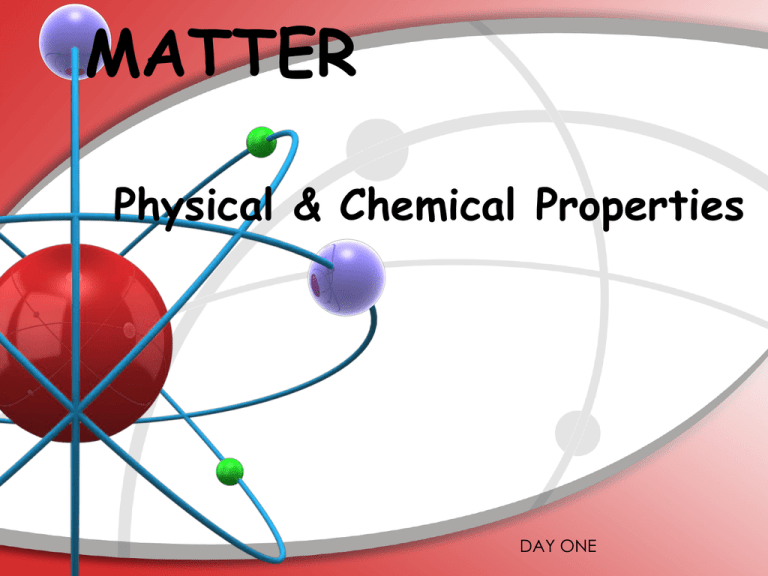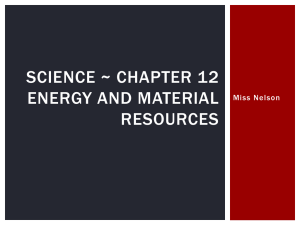powerpoint_10.24.11_
advertisement

MATTER Physical & Chemical Properties DAY ONE EQ: What’s the difference between physical and chemical properties? TIWL: how a physical property is different from a chemical property, because they both involve changes in matter. Sponge: (QUESTION) Write 10 physical features of your best friend. How does that relate to physical properties of matter? Content STANDARD & ELEMENT STANDARD Element (d) S8P2 : Students will examine the scientific view of the nature of matter. Distinguish between physical and chemical properties of matter as physical (i.e. density, melting point, boiling point) or chemical (i.e., reactivity, combustility) Language of the Standards (Today's Vocabulary) Physical Change Chemical Change Physical Property Chemical Property Law of Conservation of Mass Density ESSENTIAL QUESTION 1. What is the difference between physical & chemical properties ? WHY IS THIS IMPORTANT ? TODAY I WILL ……. how a physical property is different from a chemical property, . THIS IS IMPORTANT BECAUSE...... they both involve changes in matter. ACTIVATOR DIRECTIONS : LOOK AT EACH WORD. USING THE CARDS, DECIDE WHETHER IT IS A PHYSICAL OR CHEMICAL PROPERTY Physical Property Physical property: a property that can be observed without changing the identity of the substance. Chemical Properties Chemical property: a property that can only be observed by changing the identity of the substance Melting point • Flammability • Boiling point • Vapor pressure • Rusting • Color • State of matter • Odor • Density • Tarnishing • Electrical conductivity • Solubility • Decomposition • Adsorption to a surface • Hardness • PHYSICAL & CHEMICAL CHANGE The Learning Period DIRECTIONS : Read the scenarios & independently and fill in the t-chart. Scenario 1: Absorption of water into a towel Scenario 2: Rusting nail Scenario 3: Breaking glass Scenario 4: Rotting of fruit (decomposition) DIRECTIONS : Read the scenarios & independently and fill in the t-chart. Scenario 5: Explosion of fireworks Scenario 6: Deflating a basketball Scenario 7: Cutting a material such as wood Scenario 8: Burning a material such as wood Scenario 9: Tarnishing of Silver 3 COLUMN T-CHART Directions: to create a T-chart with the definitions & examples of physical and chemical properties. PHYSICAL PROPERTIES CHEMICAL PROPERTIES (DIRECTIONS) • • • JOURNAL WRITING ANSWER WRITING PROMPT PLACE IN JOURNAL SECTION STUDENTS WILL SHARE RESPONSES (QUESTION) Write a journal writing depicting what physical properties you notice from the gel marbles Students can refer to the textbook if needed. Closing Create a picture in your IAN notebook to distinguish between physical and chemical properties. HOMEWORK REMINDERS ………. 1. STUDY FOR THE QUIZ!!!!! STUDY ALL NOTES INCLUDING YOUR STUDY GUIDE! 2. Read the article over physical and chemical properties. Due Wednesday MATTER Physical & Chemical Changes DAY TWO •EQ: What’s the difference between physical and chemical properties? TIWL: how a physical property is different from a chemical property, because they both involve changes in matter. QUESTION: 1 . If a small amount of oil is dropped into the water, the ______ (a) oil and the water will mix. (b) oil will rise to the top of the water. (c) water will take up less space in the jar. (d) water will rise to the top of the oil. Content STANDARD & ELEMENT STANDARD Element (e) S8P2 : Students will examine the scientific view of the nature of matter. Distinguish between changes in matter as physical (i.e. physical changes) or chemical (i.e., development of a gas, formation of precipitate, and change in color). Language of the Standards (Today's Vocabulary) Physical Change Chemical Change Physical Property Chemical Property Law of Conservation of Mass Density ESSENTIAL QUESTION 1. What is the difference between physical & chemical properties ? WHY IS THIS IMPORTANT ? TODAY I WILL ……. assess what I have learned about matter. THIS IS IMPORTANT BECAUSE...... it is important for me understand what standards I have mastered. ACTIVATOR PHYSICAL & CHEMICAL CHANGE The Learning Period WE ARE TESTING !!!!! WORD SEARCH !!!!! Closing Today I felt about the quiz…… Use the subatomic particle faces to describe what you feel your performance on the quiz was: Name: Patty Proton Name: Elliott Electron Description: Negative Favorite Activity: Racing around the arcade Description: Positive Favorite Activity: Hanging out at the Nucleus Arcade Name: Nelda Neutron Description: Neutral Favorite Activity: Hanging out at the Nucleus Arcade HOMEWORK 1. Complete Word Search 2. Read the article over physical and chemical properties. Due Wednesday MATTER Physical & Chemical Changes DAY THREE •EQ: What’s density and how is it a physical property? TIWL: how density is a physical property, because its something that you can observe without changing the identity of the substance. QUESTION: A chemical change combining two elements results in _____. a. An atom b. A compound c. An element d. A mixture Content STANDARD & ELEMENT STANDARD Element (e) S8P2 : Students will examine the scientific view of the nature of matter. Distinguish between changes in matter as physical (i.e. physical changes) or chemical (i.e., development of a gas, formation of precipitate, and change in color). Language of the Standards (Today's Vocabulary) Physical Change Chemical Change Physical Property Chemical Property Law of Conservation of Mass Density ESSENTIAL QUESTION 1. What is density & how is it a physical property ? WHY IS THIS IMPORTANT ? TODAY I WILL ……. Learn how density is a physical property. THIS IS IMPORTANT BECAUSE...... it involves mass & volume. ACTIVATOR PHYSICAL & CHEMICAL CHANGE The Learning Period DENSITY SWEET DENSITY LAB CLOSING (DIRECTIONS) • • • JOURNAL WRITING ANSWER WRITING PROMPT PLACE IN JOURNAL SECTION STUDENTS WILL SHARE RESPONSES (QUESTION) Explain the outcome of the lab using two to three sentences. MATTER Physical & Chemical Changes DAY FOUR •EQ: What’s the law of conservation of matter? TIWL: about the law of conservation of matter, because the amount of matter does not change after a chemical reaction. Make a prediction about what the “law of conversation of mass/matter” means? Content STANDARD & ELEMENT STANDARD Element (e) Element (g) S8P2 : Students will examine the scientific view of the nature of matter. Distinguish between changes in matter as physical (i.e. physical changes) or chemical (i.e., development of a gas, formation of precipitate, and change in color). g. Identify and demonstrate the law of conservation of Matter. Language of the Standards (Today's Vocabulary) Physical Change Chemical Change Physical Property Chemical Property Law of Conservation of Mass Density ESSENTIAL QUESTION 1. What is the law of conservation of matter? WHY IS THIS IMPORTANT ? TODAY I WILL ……. learn about the law of conservation of matter. THIS IS IMPORTANT BECAUSE...... the amount of matter does not change after a chemical reaction. ACTIVATOR Directions: Use power thinking to summarize the definition in 10 words or less. Law of Conservation of Mass- Matter (energy)cannot be created or destroyed but it can change forms and concentration to other molecules (solid, liquid, gas, aqueous solution). Use power thinking to summarize the definition in 10 words or less. •Density • Recap yesterday’s Density, Sweet, Density Lab • Density is a physical characteristic, and is a measure of mass per unit of volume of a material or substance. PHYSICAL & CHEMICAL CHANGE The Learning Period REACTION IN A BAGGIE LAB Materials needed baking soda small plastic bag calcium chloride phenol red solution triple beam balance Complete a go green journal writing about what happened during the lab and why did the mass stay the same after the reaction. Closing Question: How does today’s lab relate to the law of conversation of mass ? HOMEWORK NO HOMEWORK !!!! MATTER Physical & Chemical Properties DAY FIVE EQ: What’s the law of conservation of matter? TIWL: about the law of conservation of matter, because the amount of matter does not change after a chemical reaction. Look at the large graduated cylinder. Explain what physical property this is showing. Content STANDARD & ELEMENT STANDARD Element (e) Element (g) S8P2 : Students will examine the scientific view of the nature of matter. Distinguish between physical and chemical properties of matter as physical (i.e. density, melting point, boiling point) or chemical (i.e., reactivity, combustibility g. Identify and demonstrate the law of conservation of Matter. Language of the Standards (Today's Vocabulary) Physical Change Chemical Change Physical Property Chemical Property Law of Conservation of Mass Density ESSENTIAL QUESTION 1. What is the law of conservation of matter? WHY IS THIS IMPORTANT ? TODAY I WILL ……. learn about the law of conservation of matter. THIS IS IMPORTANT BECAUSE...... the amount of matter does not change after a chemical reaction. ACTIVATOR PHYSICAL & CHEMICAL PROPERTIES The Learning Period DEMONSTRATION !!!! 1. 2. 3. 4. 5. Pour 2 spoonful's of baking soda in the balloon. Place the lip of the balloon over the graduated cylinder. The graduated cylinder will have about 50 ml of vinegar in it. Measure everything with a triple beam balance. Flip the balloon over the vinegar and watch the reaction. Measure everything after the reaction. CLOSING (DIRECTIONS) • • • JOURNAL WRITING ANSWER WRITING PROMPT PLACE IN JOURNAL SECTION STUDENTS WILL SHARE RESPONSES Observations “Go Green” NO HOMEWORK…..ENJOY YOUR WEEKEND !!!!










